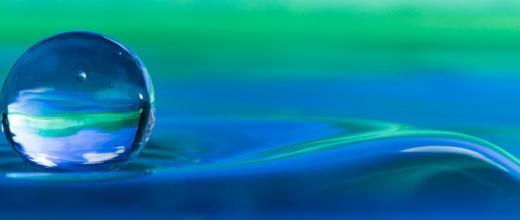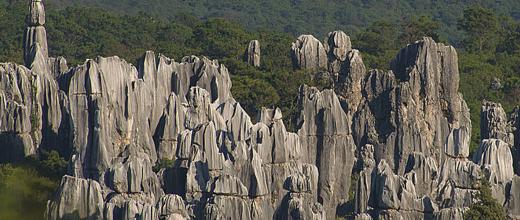Water resources are becoming scarcer as they come under increased human and climate pressure. Over-use, drought, pollution and eutrophication* are complicating management of the domestic water cycle, including in Europe, where one third of the territory is exposed to high water stress. How can we deal with this? As part of the circular economy, the European Union has made water conservation and the careful use of resources two major goals.
- The stages in the water cycle: a summary
- Our blue planet subject to high water stress
- Water resources and treatment in Europe
- The water cycle and the circular economy

The stages in the water cycle: a summary
The large water cycle
Water circulates on the Earth in different forms - clouds, rain, rivers and oceans – depending on the stage of the cycle: evaporation from the sea to the atmosphere, condensation in the atmosphere, precipitation to the ground, then collection in natural reservoirs.
The surface of the Earth is 70% water; 97% of this is seawater. That means 3% is freshwater, and ¾ of this is ice and snow, leaving ¼ as accessible freshwater (lakes, rivers, water tables).
Groundwater, which comes from rainwater infiltrating the ground, represents half of this freshwater. It is stored in aquifers, which form in porous and permeable rock. Water tables, which lie just under the surface, are the most accessible aquifers.
* The syndrome of a water ecosystem associated with the over-production of organic matter, induced by increased phosphorus and nitrogen as a result of human activity
The small water cycle
Some of the water we need is taken from water tables, for drinking water (10%), industry (20%) and agriculture (70%). The rest comes from surface water (runoff, rivers, lakes).
This is the 1st stage in the “small, or domestic, water cycle”, itself subdivided into several stages: treatment, storage, distribution, collection, decontamination and, finally, return to nature and the large cycle!
Our blue planet subject to high water stress
Due to the shaping of the Earth’s surface by the different climate cycles, water resources are unevenly distributed around the world. Access to these resources also depends on the different degrees of wealth: basically, the higher the standard of living, the more water is consumed.
On average, worldwide, each person consumes 137 Litres (or L) of water per day. The average rises to between 250 and 300 L per day in Europe and 600 L per day in North America and Japan, whereas it drops to only 10 to 20 L in Sub-Saharan Africa.
There may be additional pressure on existing water resources due to population growth, changes in consumption habits connected to changing living standards, intensive farming, pollution due to industrial waste, mining, deforestation, and global warming, with the last affecting rainfall in some regions. All of these are factors affecting the quantity of water available (over-exploitation or drought) as well as its quality (pollution and eutrophication).
Things change fast!
Over the course of the last 100 years, worldwide water use has increased sixfold and is continuing to rise rapidly, by nearly 1% per year. If this scenario persists (2030 WRG, 2009), our planet may experience a global water deficit of 40% by 2030. (Source: UNESCO)
Water resources and treatment in Europe
Is Europe affected by high water stress and shortages? The European Environment Agency (EEA) estimates that nearly one third of the EU is vulnerable to high water stress conditions, either permanently or short-term*. While Southern Europe is the most affected, some Northern regions also experience shortages.
In its last “health report” on drinking water in Europe (2018) – an analysis of 130,000 water masses (surface and underground water) over 5 years – the EEA showed that while member state efforts have reduced the sources of pollution, problems persist: 74% of underground water in Europe is of “good chemical status” whereas only 40% of surface water is rated as ecologically “good” or “very good”, although that is the minimum objective set by the Water Framework Directive.
At issue: nitrates from agricultural and metallurgical run-off, salt intrusion and hazardous material spillage that contaminates sites (e.g.: industrial sites, mining areas and waste storage facilities).
The water footprint: focus on an indicator
The first step is essential: we have to determine and monitor water resource needs and resources if we are going to implement solutions to the water problem. How can we work out how much water is being used by a person, product, company, town, or country? The Water Footprint, inspired by the carbon footprint and developed in 2002 by Arjen Y. Hoekstra for the UNESCO Water Footprint Network (WFN), is a standard international indicator that corresponds to the total virtual volume of water used to produce and consume a product or service. Did you know, for example, that it takes 140 litres of water to make a cup of coffee (125 ml)?
The water cycle and the circular economy
In this context, sustainable water management means changing from a linear economy (extraction, manufacturing, consumption, disposal) to a circular, or “3R”, economy (Reduce, Re-use, Recycle).
One of the European Union’s priorities is to improve wastewater treatment before disposal. Water cycle management is becoming more complicated, with increased amounts of wastewater, the risk of saturating sanitation systems and treatment facilities, and the fact that the appearance of emerging pollutants (pesticides, medical residue, micro-plastics) in wastewater and rainwater means new treatment procedures are required.
>> Find out more about IFPEN’s solutions for industrial water and run-off treatment
Focus on the re-use of treated wastewater (RTW)
The RTW is a key part of circular economy, and involves not only treating wastewater, but also finding new ways to use it. This conserves the resource from the beginning and limits the volumes of polluting waste dumped into the natural environment. Wastewater can be used in different ways: for irrigation, watering public spaces and industrial equipment, producing biomethane, and even recharging water tables.
Cap sur la réutilisation des eaux usées traitées (REUT)
Careful water use also requires integrated water resource management (IWRM)*. The controlled recharging of aquifers, for example, makes it possible to maintain, improve and protect underground water using various technical solutions (infiltration basins, injection bores, retention chicanes or basins on waterways, etc.)
Finally, and above all, we also need to apply the circular economy at the start of the small water cycle: we must make a major effort in this regard when designing goods and services. A life cycle assessment (LCA) applied to these goods and services identifies the production stages that consume water; it is during these stages that it is possible to find ways to limit the water footprint.
Points to remember
Of the 3% of freshwater that is part of the large water cycle on our planet, only ¼ is accessible in water tables and surface water (run-off, rivers, lakes).
In addition to the unequal distribution of water resources over the continents and countries, in different climates and stages of development, there are new pressures in the modern world: demographic growth and climate change. Problems involving water resource quantity and quality mean that water resource management must be adapted.
Since 2000, the European Union’s Water Framework Directive establishes a framework for a comprehensive community policy for water. In order to deal with the rarity of water resources, the Member States are encouraging water conservation and its rational use.
The different players involved (consumers, communities, industry) are more than ever called upon to apply the paradigm of the circular economy for water. The re-use of treated wastewater (RETW), integrated water resource management (IWRM), and, at the start of the small water cycle, the reduction of the water footprint for goods and services through environmentally-friendly design all constitute sustainable solutions for the water problem.







